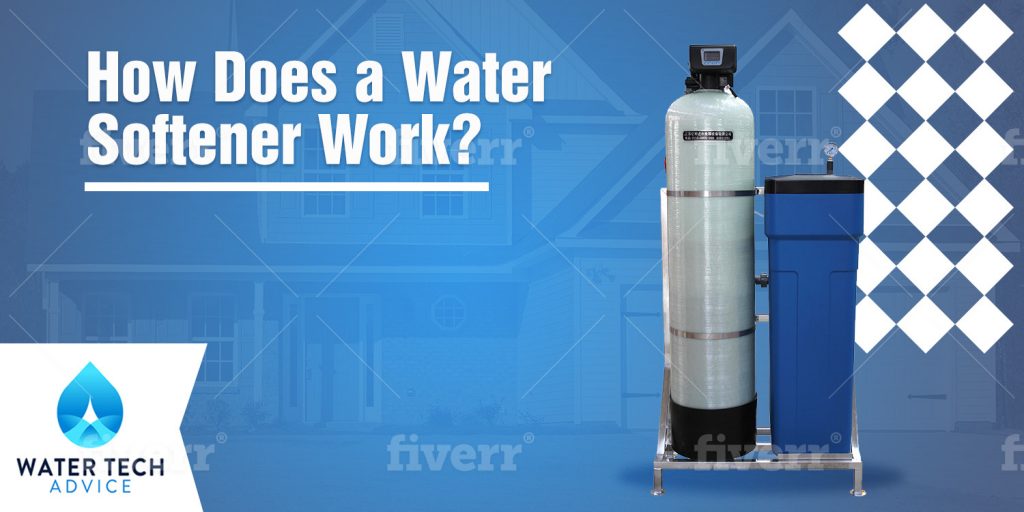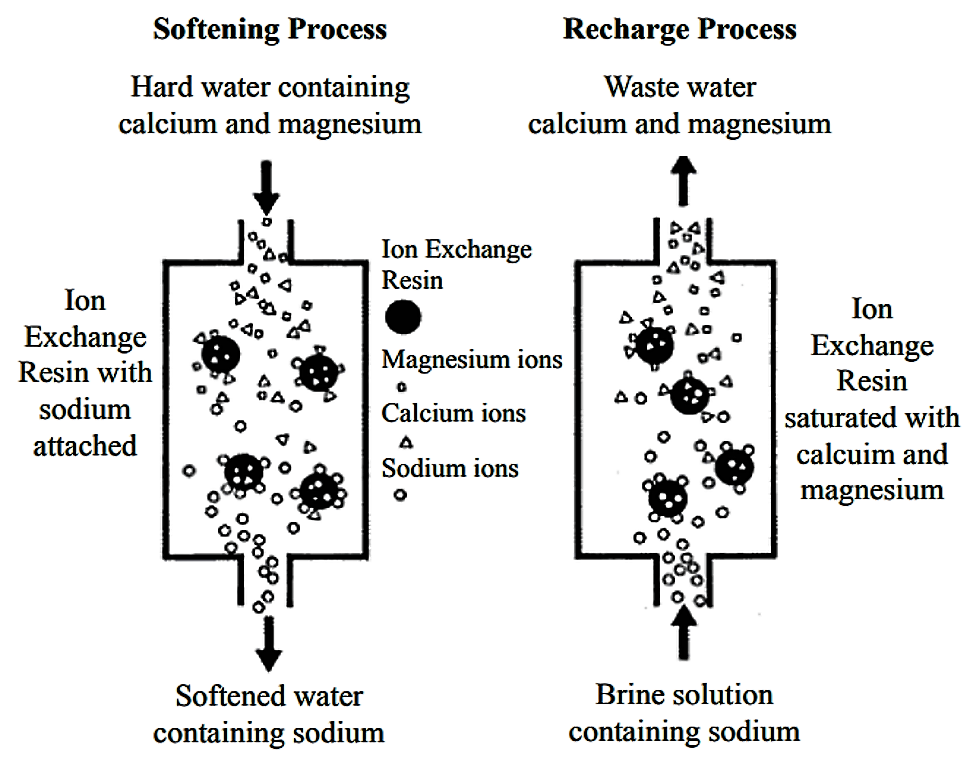
If you find that you need a lot of soap to create a lather, your skin has a residue after showering, or your appliances and pipes frequently suffer from limescale damage your home has hard water.
Luckily, you can eliminate all these problems immediately simply by installing a water softener.
But what exactly is a water softener and how does it work?
Also Check Out: Top Rated Water Softener Reviews and Buyers Guide
Table of Contents
- 1 What Is a Water Softener?
- 2 Hard Water vs Soft Water
- 3 How Does a Water Softener Work?
- 4 Salt vs Salt-Free Water Softeners
- 5 How Does Water Softener Regeneration Work?
- 6 Components of a Water Softener Device
- 7 What Contaminants Do Water Softeners Remove?
- 8 Is Soft Water Good for Drinking?
- 9 Why Use a Water Softener?
- 10 How Do You Install a Water Softener?
- 11 When Do You Need to Replace a Water Softener?
What Is a Water Softener?
A water softener can either remove the minerals that are making your water hard or change the structure of those minerals to stop them adhering to surfaces. Although they are usually sold as water softeners, the latter are actually water conditioners.
This is because they do not actually remove minerals from water, meaning water is still technically hard — although, in most ways, the water does behave as if it were soft.
Other Helpful Resources:
- How Long do Softeners Last
- How to Choose the Perfect Water Softener
- What Happens If My Softener Runs Out Of Salt?
- How to Clean a Water Softener
Hard Water vs Soft Water
Hard water is defined as having at least 7 grains per gallon of calcium carbonate or at least 60 milligrams per liter of calcium and magnesium. More than 85 percent of the population in the U.S. receive hard water. These people need to dedicate time every week to cleaning the scale left on places like faucets and shower heads, suffer from dry skin, throw out appliances prematurely, and waste water waiting for soap to lather.
With soft water, on the other hand, you have none of these problems.
For more information on how hard water becomes soft check out our how to soften hard water guide.
How Does a Water Softener Work?
How a water softener works depends on whether it removes minerals or changes the structure of minerals.
The softeners that remove minerals use a process called ion exchange. This involves exchanging calcium and magnesium ions for sodium ions.
Hard water enters the softener system and then passes through a bed of resin beads that are negatively charged with sodium ions.
Calcium and magnesium ions are positively charged, meaning they are attracted to the negative charge. As a result, the ions stick to the resin beads.
In turn, the beads release their sodium ions. The water that flows out of the system contains these sodium ions instead of the calcium and magnesium ions that were making the water hard.
Helpful Resources:
This water softening process flow diagram shows how the ion exchange works.

Softeners that change the structure of minerals in water use a different process. In fact, there are a couple possible methods. The most common is template-assisted crystallization (TAC). As the water softener diagram below shows, TAC works by sending water through polymeric beads. These beads turn magnesium and calcium into crystals that are unable to stick to surfaces.

Another type of water softener is the magnetic water scaler. This type of water softener creates an electrical field inside the pipe to change the form of the calcium and magnesium ions, making them less soluble.

Salt vs Salt-Free Water Softeners
Models that use ion exchange to soften water are salt water softeners. Those that change the structure of minerals are salt-free softeners.
As they are more effective, salt softeners are the only option for homes with extremely hard water. However, homeowners who would prefer not to increase sodium levels of water may prefer a salt-free softener. These also have the benefit that they cost less to run and require less maintenance, as there is no refilling a brine tank with salt every few weeks.
Helpful Resource: When to Add Salt to A Water Softener
How Does Water Softener Regeneration Work?
In systems that use ion exchange, the resin needs to regenerate. This allows the resin beads to keep exchanging sodium ions for magnesium and calcium ions.
The regeneration process involves washing the hard minerals off the beads and then flushing the minerals from the softener system.
Typically, it depends on the water softener and the household to determine how often a water softener will regenerate. For more information on water softener regeneration time and details see our regeneration guide here.
Components of a Water Softener Device
A water softener that uses the ion exchange method also has more parts than the other kinds of systems. There are three main components: a mineral tank, a brine tank, and a control valve.
Mineral Tank
Hard water enters the mineral tank for the ion exchange process. Once the ions are exchanged, the water exits from the bottom and continues through the pipe to your appliances and faucets.
Brine Tank
The brine tank is the shorter of the two tanks — it’s also the one you need to fill with salt pellets or blocks. Whenever it’s time for the system to regenerate, the solution inside the brine tank leaves and heads to the mineral tank to flush the resin with fresh salt.
Control Valve
As resin beads only have a limited capacity, it’s useful for the system to measure how much water passes into the mineral tank. This ensures the softener remains effective. Once the resin is saturated, the system regenerates.
What Contaminants Do Water Softeners Remove?
Water softeners that use the ion exchange process only remove calcium and magnesium from your water. Those that change the structure of minerals remove no contaminants at all.
Is Soft Water Good for Drinking?
With soft water, you consume fewer potentially-harmful minerals when you drink tap water. However, it is important to note that a water softener is not a filtration device — the water may still contain sediment and dangerous contaminants like rust, herbicides, pesticides, fluoride, parasites, and bacteria. If you receive your water from a city supply, it most likely also has a high quantity of chlorine, which can lead to an unpleasant taste or smell.
If you want to make your water safer for drinking, consider purchasing a water softener with a pre-filter. This will remove some select contaminants. Another option is to pair your water softener with a filtration solution. For water that only has a low amount of contaminants, a pitcher filter may be ideal. If your water has a higher quantity of contaminants (including if your water comes from a well), a better option may be a reverse osmosis system (for drinking water only) or even a whole-house filtration system.
Why Use a Water Softener?

Anyone who has hard water should see a water softener as a necessary investment.
The purchase price is between just $600 and $1,500. For systems that use salt, you’ll also spend between $10 and $25 in sodium chloride per month.
For this price, you’ll receive benefits like:
- No more stains on sinks, showers heads, dishes, kitchen counters, clothing, and anything else that comes into contact with water.
- Longer-lasting appliances. Plus, your appliances will be more efficient, requiring less energy to heat water. Dishwashers and washing machines will need less soap.
- You’ll also be able to use less soap when showering and for tasks like washing the car.
- Healthier skin and hair.
- No more limescale damage.
- Better-tasting water, particularly if you choose a softener with a pre-filter for chlorine.
How Do You Install a Water Softener?
The exact steps for installing your water softener will depend on the model, although most use a similar procedure. The exception is for magnetic water scalers, which are far easier to install: all you need to do is wrap the wires around the pipe and plug in the system.
- To start, you’ll need to find the right place for your water softener. It should be close to where water enters your home, as this will mean all your appliances receive softened water. Once you’ve found the right place, make sure you position the system correctly.
- Next, turn off the water supply at the mains as well as the electrical power (if your system uses electricity).
- Open a faucet (or perhaps several faucets) to drain all the water from the pipes. Once the water stops flowing, you can cut into the pipe at the place where you are installing the system.
- Attach the softener system to the pipe. This is the most complex step and does require some DIY experience. For instance, you may need to solder nipples and fittings, seal threads, or add adapters.
- For softeners with a brine tank, you also need to clamp the drain hose and set it where it can empty into a drain. You may need an air gap to prevent waste water from reentering the system. Finally, you’ll need to set up the overflow tube to stop the brine tank from overflowing.
When Do You Need to Replace a Water Softener?
How long your water softener lasts will depend on the model. The average lifespan is 15 years, but some last much longer. Many even have a warranty of 10 years, meaning there is no need to worry about them failing for a long time.
There’s a huge number of water softeners on the market, each with a different set of features and benefits. These characteristics influence the system’s lifespan, price, and suitability for your home. To choose the right product for you, it’s important to find out just how hard your water is and figure out what you are looking for in a water softener.
See our review on the best water softeners to select the appropriate model for your home.


